 |
 |
 |
| |
Impact of Baseline Antiretroviral Resistance Status on Efficacy Outcomes Among Patients Receiving Maraviroc Plus an Optimized Background Therapy (OBT) Versus Placebo Plus OBT in the MOTIVATE 1 and 2 Trials
|
| |
| |
Reported by Jules Levin
IAS Aug 3-8,, 2008, Mexico City
Commentary: this study shows the effectiveness of maraviroc in triple-class resistant patients, 50% achieve <50 c/ml. Maraviroc clearly can be extremelky helpful to patients with drug-resistance who are CCR5-tropic. The Monogram Tropism assay must be performed first to see if the patient is R5-tropic. The Monogram Tropism assay is the only assay now that has passed peer review. It is crucial that clinicians consider maraviroc for these patients. For triple-class patients it is crucial to have preferably 3 active drugs in their regimen, and of course there are 2 new classes the Merck integrase raltegravir and PfizerŐs maraviroc; in addition 2 new drugs in older classes but proven effective for patients with resistance are PI darunavir and NNRTI etravirine.
Patients with triple-class resistance or experience in MOTIVATE & 2 used 1-12 ARTs previous to the study, and had 12 years of ART experience. The triple-class resistant patients had an average of 11 PI mutations, 2 NNRTI mutations, and 7 NRTI mutations. The overall susceptibility scores were 1.0. 17% of patients receiving MVC had a 0 overal susceptibility score, meaning they werenŐt sensitive to any drugs in their OBT at screening using geno & pheno testing. 41% had a OSS of 1, meaning they were sensitive to 1 drug in OBT. They achieved an average -1.69 reduction I viral load, 50% achieved <50 c/ml. Their average baseline CD4 count was 156 and achieved an increase of 108 CD4s on MVC+OBT.
The purpose of this study was to investigate the efficacy of MVC in patients from the MOTIVATE 1 and MOTIVATE 2 studies with triple-ARV-class resistance (TCR) and in patients with triple-class experience but not triple-class resistance (nTCR) at baseline.
AUTHOR CONCLUSIONS
· Maraviroc plus OBT demonstrated immunologic and virologic benefits over placebo plus OBT regardless of the resistance status at baseline.
· These benefits applied to both subgroups of patients with triple-class resistance at baseline and patients with triple-class experience but not triple-class resistance at baseline.
· This analysis demonstrates that regardless of the level of class resistance (TCR or nTCR), in treatment-experienced patients with R5 HIV-1, maraviroc acts as a new class of drug with a unique mechanism of action as demonstrated by its virologic and immunologic efficacy.
BACKGROUND
· The level of multi-class resistance among highly antiretroviral (ARV)-treatment experienced patients on long-term therapy continues to be a pressing concern.
· Maraviroc (MVC) is the first approved oral CCR5 antagonist with potent antiviral activity in vitro and in vivo against CCR5-tropic (R5) HIV-1, including multi-drug-resistant HIV-1, but not CXCR4-tropic (X4) or dual/mixed-tropic (D/M) HIV-1.1,2
· MOTIVATE 1 (Study A4001027) and MOTIVATE 2 (A4001028) were pivotal, prospective, double-blind, placebo (PBO)-controlled, Phase 2b/3 trials assessing the safety and efficacy of MVC in treatment-experienced patients harboring only R5 HIV-1 (N=1,049).1,2
· In MOTIVATE 1 and 2, MVC plus optimized background therapy (OBT) demonstrated significantly greater virologic and immunologic efficacy and a similar safety profile compared to PBO plus OBT at 48 weeks.1,2
Change in Viral Load at Week 48
In both TCR and nTCR patients, mean HIV-1 RNA change from baseline was significantly greater with MVC versus PBO (P<0.05).
In the MVC arm, mean HIV-1 RNA change from baseline was - 1.69 and - 2.07 log10 copies/mL for patients with TCR and non-TCR, respectively.
By comparison, in the PBO arm, the mean change was -0.41 and -1.28 log10 copies/mL for patients with TCR and non-TCR, respectively.
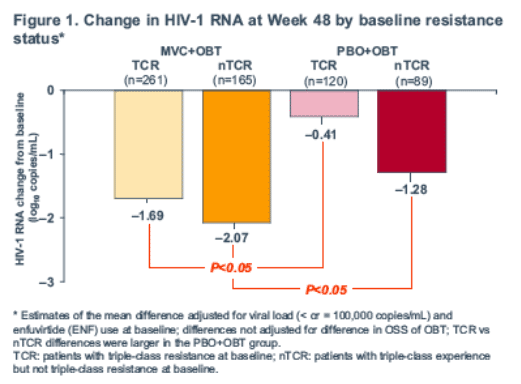
Patients Achieving HIV-1 RNA <50 copies/mL
At Week 48, 42.9% of TCR patients receiving MVC versus 10.0% of TCR patients receiving PBO achieved HIV-1 RNA <50 copies/mL (odd ratio [OR]=7.9, 95% confidence interval [CI]: 4.1-15.3; Figure 2).
Similarly, 49.7% of nTCR patients receiving MVC versus 25.8% of nTCR patients receiving PBO achieved HIV-1 RNA <50 copies/mL (OR=2.93, 95% CI: 1.7-5.2; Figure 2).
For patients receiving MVC, 42.9% versus 49.7% achieved a HIV-1 RNA of <50 copies/mL at Week 48 in the TCR and nTCR groups, respectively (Figure 2).
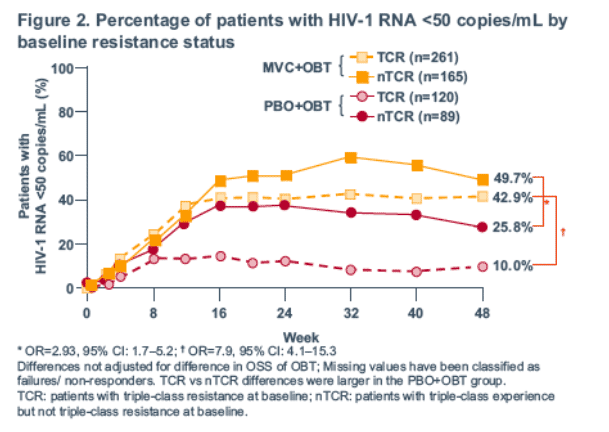
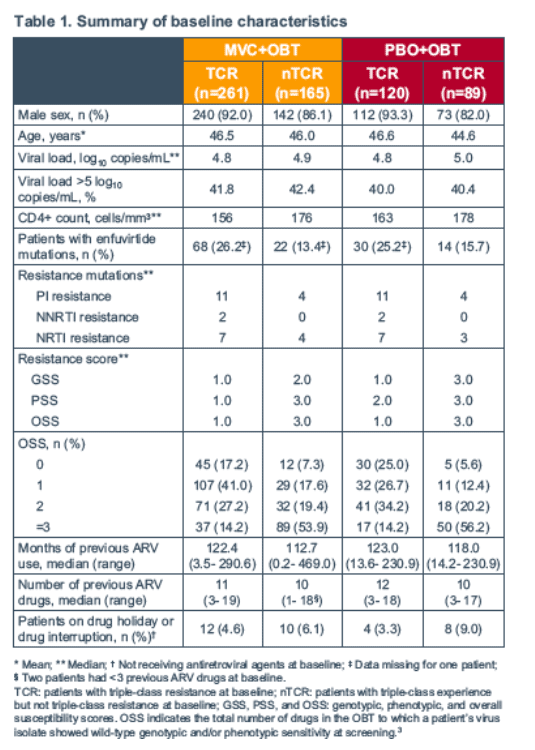
Change in CD4+ Cell Count at Week 48
Both TCR and nTCR patient subgroups receiving MVC experienced greater increases in CD4+ cell count from baseline (TCR MVC=108 cells/mm3, PBO=36 cells/mm3, P<0.001; nTCR MVC=150 cells/mm3, PBO=95 cells/mm3, P<0.001).
Mean CD4+ cell count change from baseline in the MVC groups were 108 (TCR) versus 150 (non-TCR) cells/mm3.
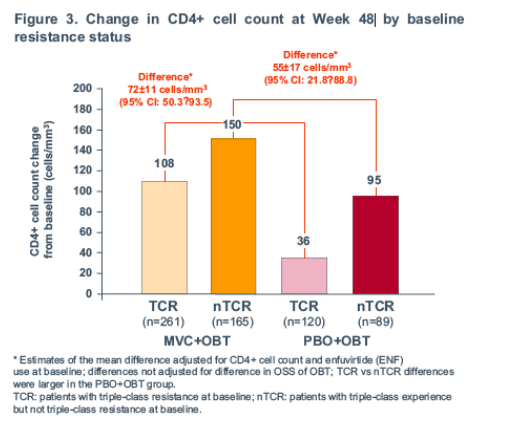
Time to Virologic Failure and Treatment Failure
For both TCR and nTCR patients, time to virologic failure and time to treatment failure (Figure 4) were significantly shorter for patients receiving PBO versus MVC (TCR MVC versus PBO, P<0.001; nTCR MVC versus PBO, P<0.001; Log-rank test).
Virologic failure had occurred in 45.6% of MVC patients with TCR versus 37.6% in the nTCR group at Week 48.
Treatment failure had occurred in 21.5% in the TCR group versus 10.3% in the nTCR group among patients receiving MVC at Week 48.
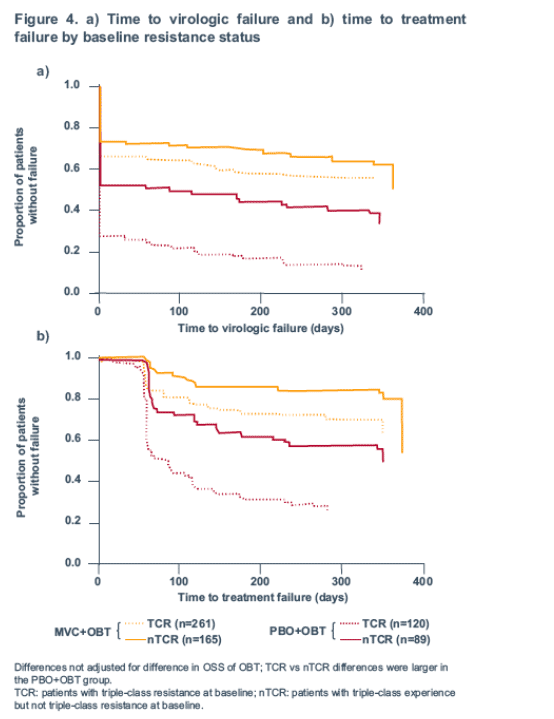
Virus Tropism Results at Treatment Failure
As expected, more patients failing treatment with MVC exhibited a change in viral tropism from R5 at baseline to X4 or D/M at treatment failure compared to PBO (Table 2).
In both the TCR and nTCR groups, a similar proportion of patients had a change in tropism result at treatment failure (Table 2).
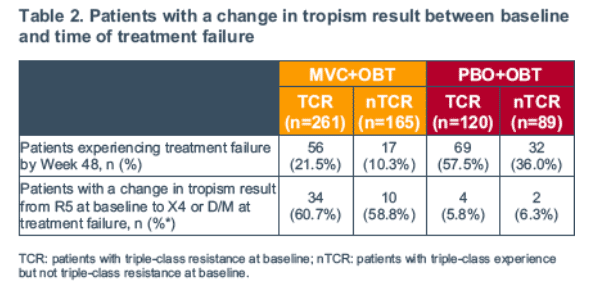
REFERENCES
1. Dorr P, et al. Antimicrob Agents Chemother 2005; 49:4721-32.
2. Hardy D, et al. 15th CROI 2008; Poster 792.
3. Gulick R, et al. 4th IAS 2007; Poster WEPEB116LB.
|
| |
|
 |
 |
|
|